Cat nutrition is the study of the dietary needs of cats to ensure their optimal health and longevity. Cats have specific dietary requirements that differ from many other animals due to their obligate carnivorous nature.
The relationship between cat nutrition and behavior can directly impact your pet’s physical and mental well-being. Certain key nutrients, such as proteins, fats, vitamins, and minerals, are not just essential for your cat’s overall health but also influence her behavior. If your cat does not receive the nutrients she needs, behavioral issues such as aggression, over-grooming, and lethargy can result.
In addition, specific nutrients such as amino acids and Omega-3 fatty acids play vital roles in keeping your cat’s brain working properly and maintaining her emotional balance. To keep your cat healthy and her behavior stable, it’s essential to tailor her diet to her needs, considering her age, weight, and any underlying health conditions.
Providing your cat with certain key nutrients is essential for your pet’s overall well-being, vitality, and good behavior throughout her life.
- Protein is the cornerstone of a cat’s diet, supporting muscle maintenance, immune function, and energy production.
- Fat and fatty acid fuels energy, maintains a healthy skin and coat and aids in various cellular processes.
- Cats have a unique dietary need for taurine, an amino acid that’s critical for a healthy heart, vision, and reproductive function.
- Vitamins, including A, D, and E, together with minerals such as calcium and phosphorus, build strong bones, immune resilience, and other vital metabolic functions.
- Access to clean water 24/7 is critical to keep the cat well-hydrated, ensuring healthy kidney function and an overall hydration balance.
Without access to the correct nutritional balance, your cat won’t be able to focus on her training, her behavior could become unpredictable, and her life expectancy could even be shortened.
Keep reading to learn about the types of cat food available and the different nutrition your cat needs throughout her life stages. We also give you many handy tips on how to feed your cat correctly and avoid common cat-feeding mistakes.
What Nutrients Do Cats Need?
Cats need specific key nutrients in their diet to maintain good health, specifically proteins, fats, and certain vitamins and minerals.
Importance Of Protein In A Cat’s Diet
Cats are obligate carnivores, meaning that protein is an essential nutrient in their diet and should form at least 70% of it.
Muscle Maintenance and Growth
Cats are muscular, agile animals, and protein is essential for maintaining and building their lean muscle mass and supporting physical strength and agility.
Tissue Repair
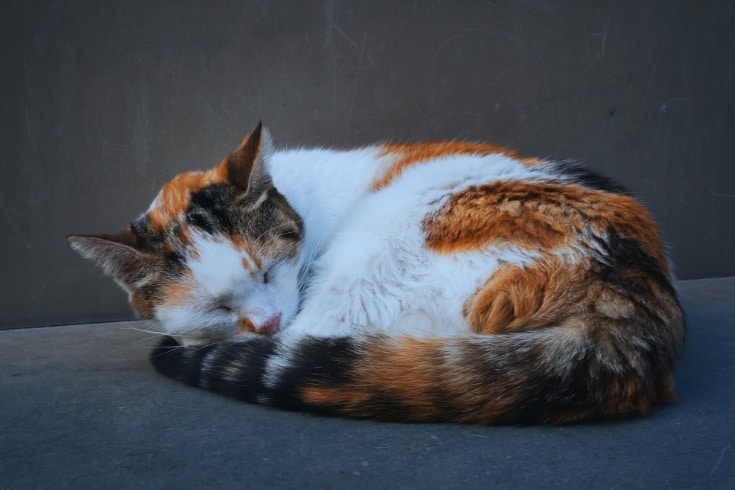
Cat’s bodies constantly undergo wear and tear, and protein is necessary to efficiently repair damaged tissues, including muscles and organs.
Enzyme and Hormone Production
Many of the enzymes and hormones in your cat’s body are protein based. these substances play vital roles in a variety of metabolic processes, including digestion, immune response, and your cat’s overall health.
Immune System Function
Proteins produce antibodies and other immune system components that help your cat fight disease and infections.
Energy Source
Although fat is the main energy source for your cat, protein can be broken down into amino acids, which are then converted into energy when required.
A protein-deficient diet leads to muscle wastage, weakened immune function, and other serious health problems, so you must provide high-quality animal-based protein in your cat’s diet to meet her unique nutritional needs,
The Role Of Fats And Carbohydrates
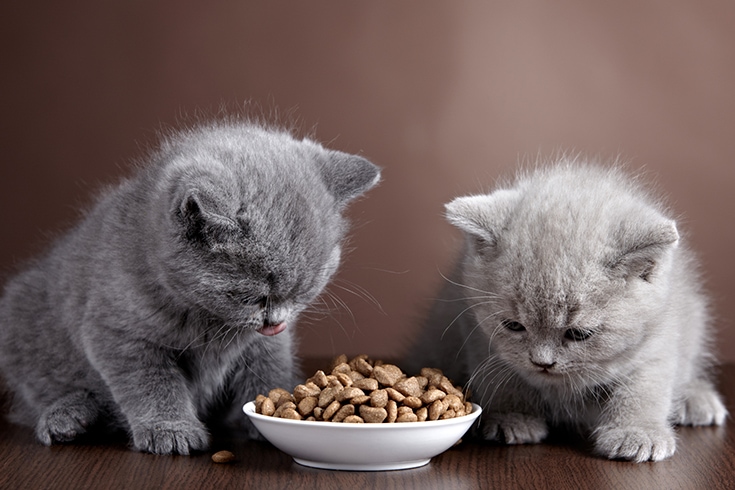
Fats and carbohydrates are also essential nutrients that your cat needs in her diet. These nutrients are essential for providing energy for daily activities and maintaining bodily functions.
Fats
Fats provide a concentrated energy source and are essential for the absorption of fat-soluble vitamins A, D, E, and K. In addition, fats help to maintain healthy skin and coat and support nervous system function.
Cats also need fatty acids, including Omega-3 and Omega-6, which are primarily found in certain plant oils, fish, and animal fats.
Carbohydrates
Cats have a somewhat limited ability to utilize carbohydrates as an energy source because their digestive systems are more adapted to process protein and fat. So, although small amounts of carbohydrates can be included in your cat’s diet as a fiber source or for energy, they should not form a significant portion of her food since a high carbohydrate diet can cause obesity and other health issues.
How Much Should Cats Eat?
The amount of food your cat should eat every day depends on several factors, including her age, weight, activity levels, metabolism, and whether you are feeding her wet or dry food.
- Commercial cat food brands always provide feeding guidelines on their packaging, so be sure to follow them when working out how much to feed your cat.
- Kittens need more calories and nutrients to fuel their growth, so they usually need to eat more frequently and have larger portions than adult cats, while senior cats might have different dietary requirements, so the amount of food they need will probably vary.
- If your cat is at a healthy weight, simply follow the feeding guidelines on the cat food packaging. However, if your cat is overweight or underweight, you might need to adjust the portion size accordingly, following your vet’s guidance on managing your cat’s weight.
- Generally, cats that spend much of their time outdoors tend to burn more calories, so they need larger food portions. In comparison, indoor cats might be less active, require fewer calories, and therefore need smaller food portions.
- Cats are natural grazers, so splitting their daily food allowance into several small meals throughout the day works best. That can also help to prevent overeating and regulates the cat’s metabolism.
- Choosing the right type of food for your cat is critical. High-quality commercial cat food provides balanced nutrition, and the feeding guidelines are specific to the brand and formula. Generally, wet cat food contains more moisture and therefore helps with hydration, while dry food tends to be more calorie-dense.
What Type Of Foods Should Cats Eat?
There are many different types of cat food on the market, and choosing one can be mindboggling!
Cats have evolved to be obligate carnivores or hypercarnivores, animals whose diet must consist of at least 70% meaty protein and cannot properly digest plant and vegetable matter.
Other obligate carnivores include tigers, lions, and other big cats, as well as the domesticated moggy. These formidable predators have developed heavy skulls and strong facial muscles designed to hold prey, cut flesh, and grind bones. In addition, many obligate carnivores have a special fourth upper molar and first lower molar that close together in a shearing action like scissors, allowing the animal to slice meat from its prey.
What Are The Different Types Of Cat Food
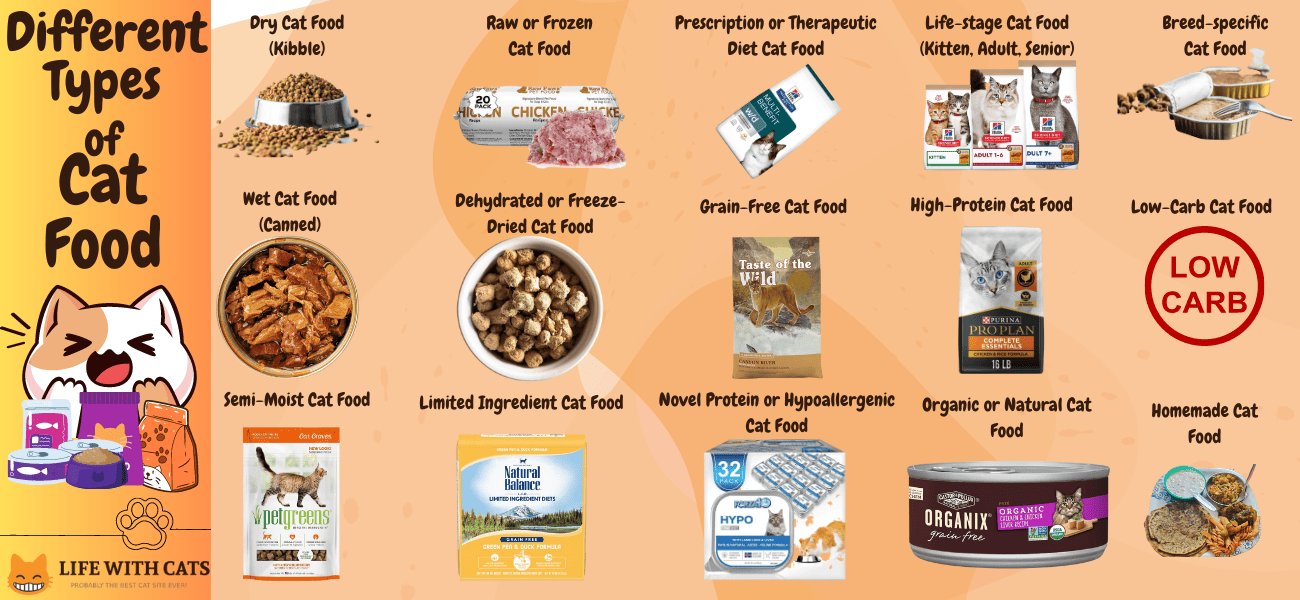
There are many different types of cat food, including dried biscuits (kibble), wet food, grain-free, veterinary diet foods, and raw or frozen food.
In the next part of our guide, you can learn about all the different types of cat food and assess their suitability for your feline friend.
Dry Cat Food (Kibble)
Dry cat food is also known as kibble and comes in small bite-sized biscuits. Kibble is typically made by extrusion, where all the ingredients are combined, cooked, and shaped under high pressure and temperature and usually contains a combination of protein, carbohydrates, fats, vitamins, and minerals to provide a balanced diet for your pet.
PROS
- Dry cat food is easy to store and measure out for feeding.
- Kibble is designed to promote dental health by scraping away plaque and tartar as the cat munches on the crunchy pieces.
- Dry cat food is usually more affordable than wet cat food, making it a budget-friendly option.
- Kibble has a longer shelf life compared to wet cat food.
- Precise portion measurement makes managing your cat’s diet and weight easier.
CONS
- Dry cat food has a lower moisture content than wet cat food, so might not be suitable for cats who need more hydration.
- Ingredient quality in dry cat food can vary widely between brands and formulations, so you must always choose a high-quality, reputable brand.
- Some cats find dry cat food less appealing than wet food due to its texture and taste.
- Cats with poor dentition and very young kittens sometimes struggle to eat dried cat food.
Blue Buffalo Wilderness High Protein Dry Cat Food
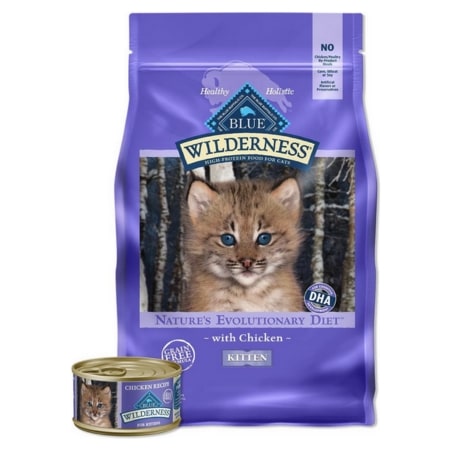
Wet Cat Food (Canned)
Wet cat food comes in sealed cans and is made from a combination of meat, poultry, fish, and sometimes vegetables, which are cooked and processed to create a moist, palatable texture that most cats love.
PROS
- Wet cat food contains a significant amount of moisture, which helps to keep your cat hydrated and supports her urinary tract health.
- Many cats prefer wet cat food’s texture and flavor to dried cat food, making it an excellent option for fussy feeders or cats with dental issues.
- Wet cat food typically offers a wider variety of protein sources and flavors, which can prevent your cat from becoming bored and provide a more balanced diet.
- Some wet cat food formulations are designed specifically for weight management, providing controlled calories that can help with weight loss or maintenance.
- Because of its high moisture content, wet cat food is often gentler on the digestive system, making it good for cats with sensitive stomachs or gastric issues.
- Senior cats with dental problems or reduced appetite can benefit from wet cat food’s softer texture and more tempting smells.
CONS
- Wet cat food is usually more expensive per serving compared to dry cat food.
- Once you have opened a can of wet cat food, you must use it relatively quickly and refrigerate it to prevent spoilage.
- The wet texture of the food is messier to serve compared to dry kibble.
- Although wet cat food is undoubtedly easier for your cat to chew, it doesn’t have the same teeth-cleaning benefits as crunchy kibble.
Purina Fancy Feast Gravy Lovers Poultry and Beef Gourmet Wet Cat Food
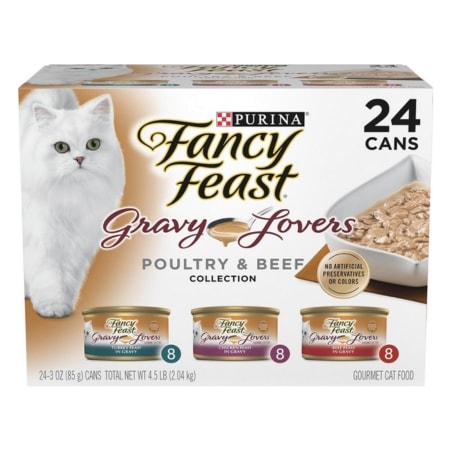
Semi-Moist Cat Food
Semi-moist cat food falls between dry kibble and wet cat food in terms of moisture content. This type of cat food typically has a higher moisture content than kibble but lower than wet canned food. Semi-moist cat food has a unique manufacturing process that entails cooking the ingredients and then replacing moisture to create a tender, chewy texture that many cats enjoy.
PROS
- Cats often find the chewy texture of semi-moist cat food highly palatable, making it a great choice for fussy feeders.
- Semi-moist cat food provides more hydration than kibble, helping to maintain a cat’s fluid intake.
- This type of cat food is easier and less messy to serve than wet food and doesn’t require refrigeration once the pack is open.
- The processing method used to create semi-moist cat food generally enhances its flavor and aroma, making it appealing to cats with poor appetites.
- Some cat owners use semi-moist cat food as a training treat.
CONS
- Semi-moist cat food is sometimes not as nutritionally balanced as high-quality wet or dry cat food types.
- Some semi-moist cat foods contain artificial preservatives, colors, and flavors to give the food a longer shelf life and maintain its chewy texture.
- Semi-moist cat food is often more expensive than both kibble and high-quality wet food.
- The chewy texture of semi-moist cat food doesn’t offer the same teeth-cleaning benefits as dry kibble.
Purina Friskies Dry Cat Food, Tender & Crunchy Combo
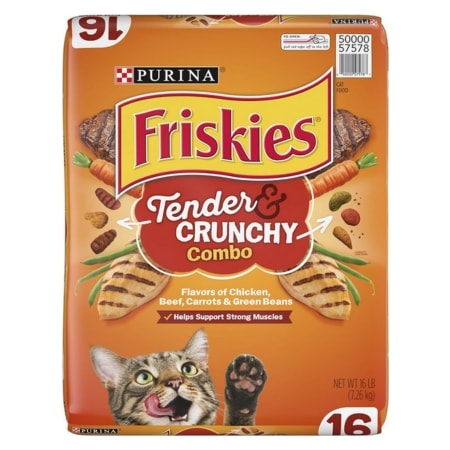
Raw Or Frozen Cat Food
Raw cat food consists of uncooked ingredients, including meat, organs, bones, and sometimes vegetables and supplements and is designed to mimic a cat’s natural wild diet, which would consist mainly of prey animals. you can make raw cat food at home or buy prepackaged commercially prepared raw food.
PROS
- Raw cat food closely resembles a cat’s natural diet, containing high levels of protein and very little carbohydrate, which is healthier for your cat.
- Raw food contains bones which can help to clean the cat’s teeth when she chews them, helping to maintain good dental health.
- Many cat owners who feed their pets a raw diet claim that it promotes a shinier coat and healthier skin.
- Cats with food allergies or sensitivities sometimes do better on a raw diet since it typically contains fewer additives and fillers.
CONS
- Raw meat can contain harmful bacteria, such as salmonella or E. coli, which can pose a risk to both cats and their owners.
- Creating a raw diet that is nutritionally balanced is challenging because cats require specific nutrients that might be lacking in a homemade raw diet.
- Preparing a balanced raw diet at home is time-consuming since it involves finding appropriate ingredients, portioning them, and ensuring the diet is nutritionally complete.
- High-quality raw diet ingredients are quite expensive, both in terms of the meat and any supplements you decide to add.
Untamed Raw Cat Food
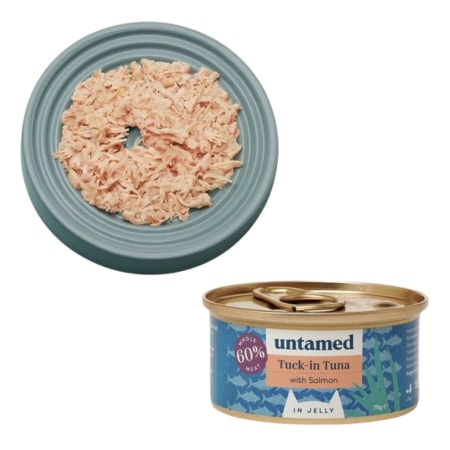
Frozen Cat Food
Frozen cat food is generally a commercial product made that are then frozen to preserve freshness and comes in various forms including nuggets, raw meat patties, and chunks.
PROS
- Frozen cat food balances raw feeding and the convenience of a ready-made product, and it’s easier to handle them preparing a raw diet from scratch.
- Commercially produced frozen cat food undergoes rigorous safety checks, reducing bacteria contamination risk.
- Most frozen cat foods are formulated to produce a balanced diet containing all the nutrients your cat needs, saving you the additional expense of supplementation.
- Commercially produced frozen cat food typically comes in a wide range of protein sources and flavors so that you can give your cat plenty of variety in her diet.
CONS
- Frozen cat food is regarded as a premium pet food and is usually more expensive than traditional dry or wet food options.
- Frozen cat food is less readily or widely available than dry or wet food.
Dehydrated Or Freeze-Dried Cat Food
Freeze-dried or dehydrated cat food is a minimally processed food that offers pet owners a convenient, handy alternative to kibble and wet food. This type of cat food is made by extracting most of the moisture from the food’s raw ingredients while preserving their nutritional value and flavor before repackaging the food for easy rehydration before feeding.
PROS
- Freeze-drying preparation methods help to preserve the natural nutrients contained in the raw ingredients, so you end up with a more nutrient-dense food for your cat.
- Because freeze-dried foods require minimal processing, they usually contain fewer preservatives, artificial flavors, and additives than some traditional cat foods.
- Many cats, including mine, enjoy the texture and flavor of dehydrated foods, which is great for picky eaters.
- These foods usually have a longer shelf life than wet foods, reducing the need for preservatives and making storage more convenient.
CONS
- Freeze-dried cat food is often more expensive compared to wet and dry foods.
- Rehydrating the cat food is time-consuming and can be less convenient for some owners.
- Freeze-dried foods tend to be calorie-dense, so it’s important to measure portions carefully not to overfeed your cat.
Stella & Chewy’s Duck Duck Goose Dinner Morsels Freeze-Dried Raw Cat Food
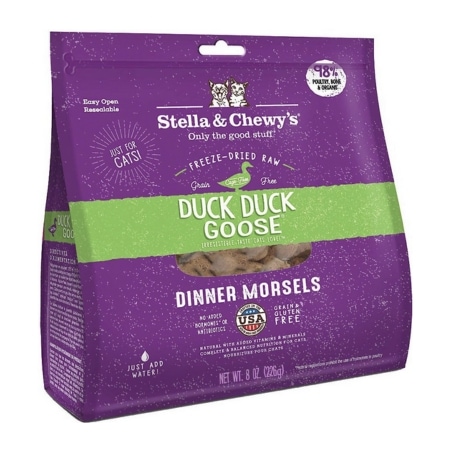
Prescription Or Therapeutic Diet Cat Food
Prescription or therapeutic diet cat food is specially formulated food prescribed by vets to manage or treat specific health concerns or medical conditions in cats, such as gastrointestinal disorders, diabetes, kidney disease, allergies, and more.
PROS
- Prescription diets provide specific nutrients to help manage various health conditions and can be a crucial part of a therapeutic plan for cats with chronic diseases or specific dietary needs.
- This type of food is tailored to meet the specific nutritional requirements of cats with health issues, such as low phosphorus for kidney disease or limited ingredients for allergies.
- These diets are generally recommended by vets based on the cat’s individual health needs and can be adjusted as part of an ongoing treatment regime.
- Prescription diets are produced by reputable pet food manufacturers that are deer to very strict quality control standards.
CONS
- Prescription diets are almost always more expensive than regular cat food because of their specialized formulations and the demanded quality standards.
- Sometimes, you can only get a prescription diet through a vet or authorized retailer, which makes them less accessible than regular cat food.
- Veterinary diets tend to be less appetizing than traditional ones, meaning your cat might not accept the taste or texture.
- Prescription diets are typically bland and come in a very limited range of flavors and options compared to regular cat food.
Hills Prescription Diets
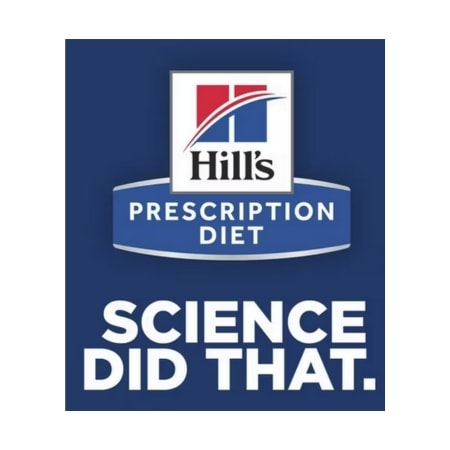
Life-Stage Cat Food (Kitten, Adult, Senior)
Each of your cat’s life stages has its own unique dietary needs to support growth, maintenance, and overall health, and life-stage cat food is specifically formulated to meet the nutritional needs of cats at different stages of their lives, such as kitten, adult, and senior.
PROS
- Life-stage cat food is formulated to give your cat what she needs at every life stage.
- This type of food comes in dry and wet formats.
- Life-stage cat food comes in a wide range of flavors to suit most cats’ preferences.
CONS
- Life-stage foods are only designed to cater to the cat’s specific life stage, so they’re not very versatile.
Purina Fancy Feast Wet Kitten Food, Tender Ocean Whitefish Feast
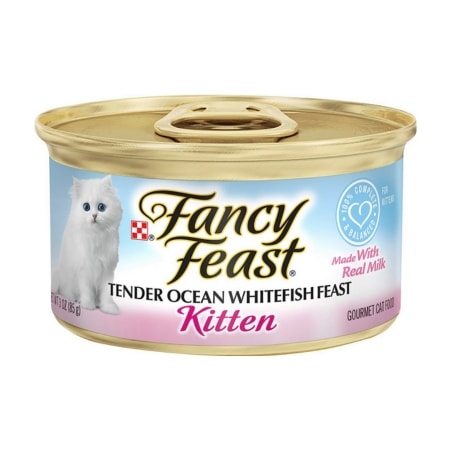
Breed-Specific Cat Food
Breed-specific cat food is formulated to meet the nutritional needs of certain cat breeds, such as metabolism, size, and potential health problems.
PROS
- Breed-specific cat foods are formulated to meet the specific dietary needs of a particular breed of cat, such as long coats and sensitive tummies.
- Some cat breeds tend to gain or lose weight, and breed-specific cat foods can help manage weight by regulating calorie intake and providing a suitable balance of nutrients.
- Some cat breeds are more susceptible to dental problems than others, and breed-specific foods sometimes include kibble shapes and textures that reduce plaque and tartar buildup, promoting better dental health.
CONS
- Breed-specific cat foods are not generally as widely available as regular foods, potentially making it difficult to find one for your cat’s breed, especially in smaller pet stores.
- This type of food tends to be much more expensive than regular cat food, and that cost can add up over time, especially if you have several different cat breeds in your household.
Royal Canin Bengal Adult Cat Food
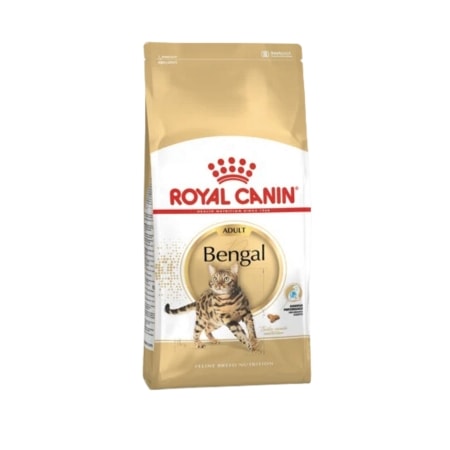
Grain-Free Cat Food
Grain-free cat food is a type of food that doesn’t contain grains, such as wheat, corn, barley, and rice, instead relying on protein sources from meat, poultry, and fish. The idea of a grain-free cat diet is to replicate a natural obligate diet for cats.
PROS
- Some cats can have allergies or sensitivities to grains, causing gastrointestinal problems and skin issues, and grain-free cat food can help to relieve those problems by removing potential allergens from the diet.
- Grain-free cat foods typically have a high protein content which matches a cat’s natural dietary needs.
- The increased protein content in this type of cat food can help weight management because cats feel fuller for longer, making them less inclined to eat too much and become overweight.
CONS
- Grain-free cat food can be more expensive than regular cat food because of the higher quality ingredients used.
- Cats transitioning from a regular diet to a grain-free diet sometimes experience upset stomachs initially as their bodies adjust to a different type of food.
Wellness CORE Grain-Free Kitten Formula Dry Cat Food
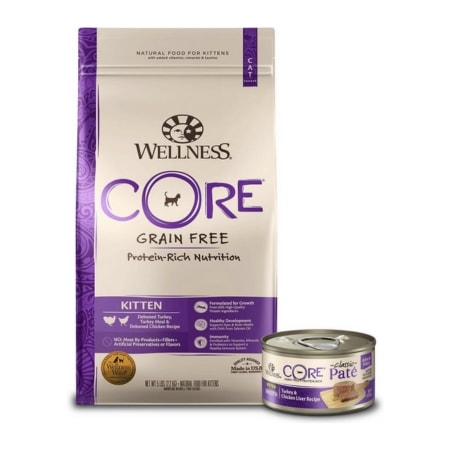
High-Protein Cat Food
High protein cat food is often labeled as “H3” and is a specialized type of food that contains more protein than standard cat food. This type of cat food mimics the cat’s obligate natural diet, which is high in protein from animal sources, so it typically contains more meat, poultry, and fish than regular cat food.
PROS
- High-protein cat food supports overall muscle health and development as well as provides valuable energy for active cats.
- This type of cat food provides essential amino acids that your cat needs for various bodily functions, including immune system support, skin and coat health, and other metabolic processes.
- High-protein cat food helps your cat feel fuller for longer, reducing the risk of overeating and helping to promote a healthy weight.
- This type of cat food generally contains fewer fillers and carbs, making digestion easier and leading to improved digestive health and a lower risk of gastrointestinal problems.
CONS
- High protein cat food is often more expensive than regular cat food because of its formulation’s higher quantity of animal-based protein.
- Excessive protein intake is potentially damaging to the cat’s kidneys, especially in older cats or those with pre-existing kidney conditions.
- Your cat needs a well-balanced diet that includes vitamins, minerals, fats, and protein, so be sure to check that the food is nutritionally complete.
Purina ONE True Instinct Grain Free High Protein, Natural Formula Adult Dry and Wet Cat Food
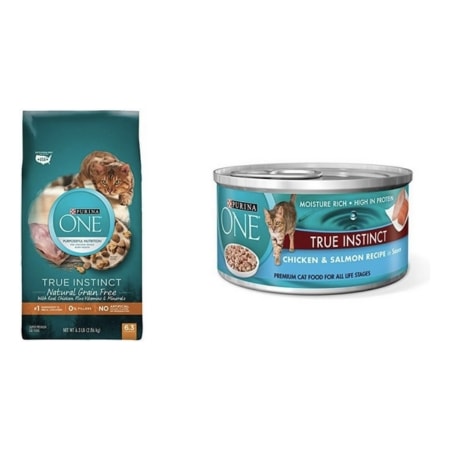
Low-Carb Cat Food
Lowc-arb cat food is designed for cats that need a reduced carbohydrate content in their diets and typically contain a higher proportion of animal-based proteins and fats while minimizing the inclusion of grains and other carbohydrate sources.
PROS
- Feeding a low-carb diet to your cat can contribute to better overall well-being, weight management, and prevention of certain health conditions, including diabetes.
- A low-carb diet can be extremely helpful for overweight or obese cats because it encourages the use of fat as a primary energy source instead of storing it, aiding in weight loss and maintenance.
- Cats are prone to developing diabetes, and a low-carb diet can help regulate blood sugar levels, potentially reducing the risk of the condition developing.
- A low-carb diet is easier for cats to digest, meaning your pet is less likely to suffer from tummy upsets.
CONS
- Low-carb diets tend to be less readily available than traditional food options.
- This type of food contains higher-quality animal protein sources and fats, which makes it more expensive than regular cat food.
Purina Pro Plan Veterinary Diets DM Dietetic Management Dry Cat Food
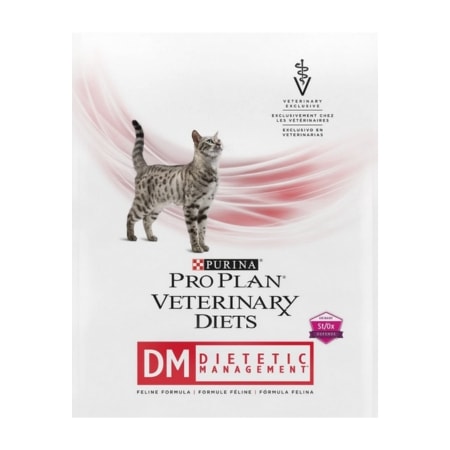
Limited-Ingredient Cat Food
Limited-ingredient cat food is a highly specialized type of food that contains few ingredients, usually with a focus on one protein source and fewer additives. This type of food is usually aimed at cats with food sensitivities, digestive issues, or allergies and is often prescribed by vets as part of an ongoing treatment program.
The idea behind limited-ingredient cat food is to reduce triggering adverse reactions and simplify the diet by selectively eliminating various possible allergens.
PROS
- This type of cat food can be helpful for cats with food allergies or sensitivities because it makes it easier to identify and avoid triggers.
- Cats with sensitive stomachs often do well on limited-ingredient diets.
- Limited ingredient diets generally don’t contain wheat, soy, corn, or artificial additives, which can help cats prone to allergic reactions.
- Some limited-ingredient diets are intended to help with weight loss because they focus on lean protein and low carbohydrate content.
CONS
- Depending on the product formulation, the food might be poorly balanced and not fulfill your cat’s nutritional needs.
- Limited ingredient cat food is often much more expensive than regular cat food.
- There’s no guarantee that a limited-ingredient diet will help your cat’s allergies or sensitivities.
Natural Balance Limited Ingredient Grain Free Salmon & Green Pea Recipe Dry Cat Food
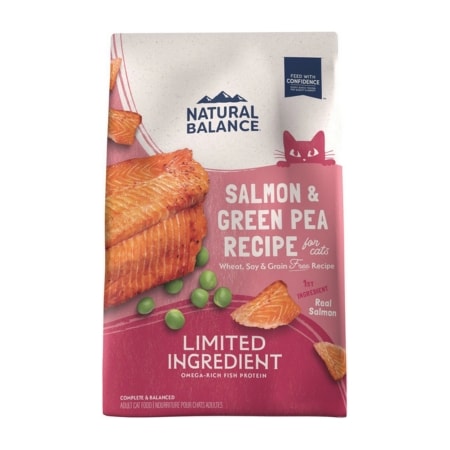
Novel Protein Or Hypoallergenic Cat Food
Novel protein or hypoallergenic cat food is a specialized food that uses uncommon or novel protein sources, such as venison, duck, rabbit, or other less common protein sources that the cat might not have eaten before. The idea of this type of cat food is to avoid sensitivities to more common protein sources like beef and chicken that cats can develop over time.
PROS
- Novel protein cat food is generally recommended for cats with suspected sensitivities and food allergies to common proteins because using a protein source that the cat hasn’t eaten before can help prevent allergic reactions.
CONS
- Novel protein cat foods are not generally widely available, and they can be more expensive because they contain less common protein sources.
- Fussy cats might not appreciate a new protein source in their diet and could reject the new food.
PET-EVER Freeze Dried Raw Cat Food 96% Raw Meat 60% Protein Rich Hypoallergenic Dry Cat Food
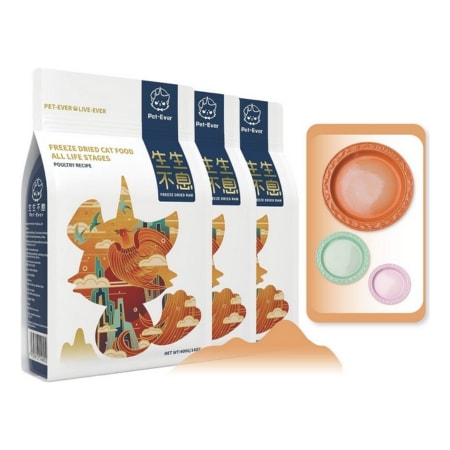
Organic Or Natural Cat Food
Organic or natural cat food is made using organic ingredients that avoid the use of pesticides, herbicides, genetically modified organisms (GMOs), and antibiotics. These foods provide a natural and wholesome diet for your cat by using only high quality ingredients that are free from potentially harmful chemicals.
PROS
- Organic cat food uses ingredients that are not exposed to synthetic pesticides and other chemicals, making this a healthier option for your cat.
- Organic cat food is widely regarded as more environmentally friendly than regular cat food.
CONS
- Organic cat food is generally a lot more expensive than regular cat food because of the cost of the ingredients used.
- It’s worth noting that not all organic cat foods meet the nutritional needs of cats, so you must read the labels carefully to ensure the food contains everything your cat needs.
ORGANIX Organic Chicken & Brown Rice Recipe Dry Cat Food
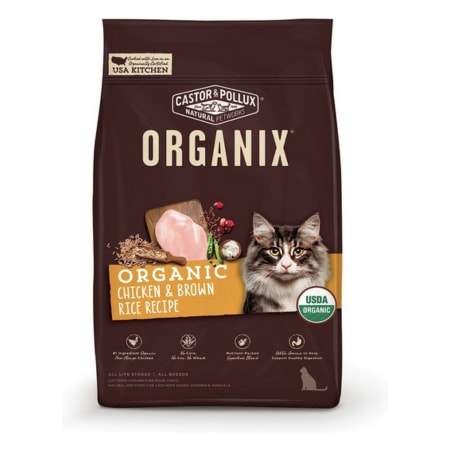
Homemade Cat Food
As the name suggests, homemade cat food is food you prepare in your own home, using a combination of ingredients that provide everything your cat needs for a healthy diet. You can tailor the recipes to suit your cat’s preferences and specific needs and include a mixture of protein, carbohydrates, fats, vitamins, and minerals for a well-balanced diet.
PROS
- By making your cat’s food at home, you have complete control over what goes into it, ensuring your pet enjoys the highest quality, fresh and appropriate foods.
- Homemade cat food means you can customize the diet to suit your cat’s health conditions or dietary restrictions.
- When you make the food yourself, you can avoid using artificial additives, preservatives, and fillers that you often find in commercially produced cat food.
- Homemade cat food allows you to offer your cat a wide variety of flavors and textures, which can prevent your cat from becoming bored.
- Standing in your kitchen preparing your cat’s meals is an excellent way of strengthening the bond between you and your pet.
CONS
- If you decide to take the DIY route to preparing your cat’s food, you will need to plan the recipes carefully so that they include the right proportions of nutrients to give your cat everything she needs.
- Preparing homemade cat food is pretty time-consuming, especially if you’re cooking in bulk to last for a few days.
- If you don’t carry out sufficient research, there’s a risk of feeding your cat a diet that’s deficient in essential nutrients, which could lead to health problems.
- There is a risk of bacterial contamination if you don’t properly handle, cook, or store homemade cat food.
- Depending on what ingredients you use, homemade cat food can sometimes be a lot more expensive than commercially prepared products.
Homemade Chicken and Rice Cat Food Recipe
Here’s a tasty chicken and rice cat food recipe that I sometimes make for both of my cats.
Ingredients:
- 1 cup cooked chicken (boneless and skinless)
- ¼ cup cooked rice
- ¼ teaspoon fish oil (for Omega-3 fatty acids)
- ⅛ teaspoon taurine supplement (essential amino acid for cats)
- ¼ teaspoon powdered calcium supplement (omit if feeding bone-in chicken)
- Water as required
Method:
1. Cook the chicken thoroughly, removing any bones, and chop into small cat-sized pieces.
2. Cook the rice according to the package instructions.
3. Place the cooked chicken, cooked rice, fish oil, calcium supplement (if using), and taurine supplement in a bowl and mix them well together.
4. If necessary, add a small amount of water to moisten the mixture to create a consistency that’s wet enough for your cat to eat comfortably.
You can store the food in the fridge for up to four days or freeze portions for longer storage.
What Are Special Dietary Considerations For Different Life Stages
Just like you and me, cats have specific nutritional needs that change as they move from one life stage to another, and providing your cat with the correct nutrition throughout her life is essential for her health, well-being, and longevity.
In this part of our guide, we will explain the specific nutritional needs of kittens, adult cats, and senior cats.
Kitten Nutrition Requirements
Kittens are incredibly active and are in a rapid growth and development phase, so they need more energy, protein, and certain nutrients compared to adult cats.
Protein: Kittens need lots of protein to support muscle and tissue growth and build strong bones, teeth, and their overall body structure.
Fat: Adequate fat in your kitten’s diet is essential for energy and healthy skin and coat development.
Calcium and Phosphorus: Calcium and phosphorus are essential for bone and teeth formation, and the right balance of these minerals is essential to avoid developmental issues.
DHA (Docosahexaenoic Acid): DHA is an Omega-3 fatty acid that specifically supports healthy brain and eye development in kittens and is always included in kitten-specific food.
As you’ll know, if you have one of these delightful little furbabies, kittens have small stomachs but very high energy needs! I found that my kittens were happiest when fed four or even five small meals every day, and fortunately, I work from home, so I was able to provide that for them.
Adult Cat Nutrition Requirements
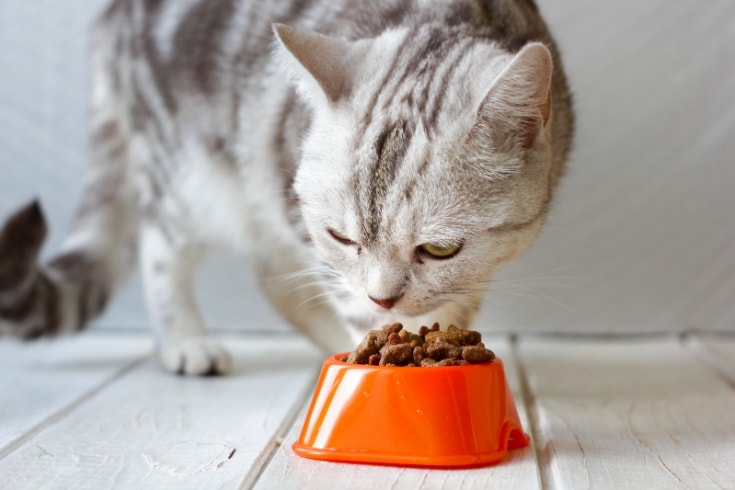
Once your cat reaches adulthood, her nutritional needs change. Adult cats typically have lower energy requirements than kittens and are no longer growing, so keeping an eye on your cat’s weight becomes very important.
Balanced Diet: Adult cats need balanced diets that contain plenty of protein for muscle maintenance, fat for energy, and fiber for digestive health.
Weight Management: Obesity causes diabetes and heart problems, so portion control and feeding an appropriate diet for your cat’s activity levels is critical to help her maintain a healthy weight.
Hydration: Cats can be very susceptible to urinary tract and kidney problems, so they need access to clean, fresh water 24/7.
Hairball Control: Adult cats tend to groom themselves much more than kittens, which can result in hairball formation, and feeding your cat a diet that includes added fiber can help to reduce and prevent hairball formation.
Senior Cat Nutrition Requirements
As cats enter their senior years, their metabolism, activity levels, and nutrient requirements change quite dramatically.
Joint Health: Senior cats often develop joint problems, such as arthritis, and feeding joint-supporting nutrients like chondroitin and glucosamine can help keep your old cat mobile and comfortable.
Digestive Health: Be aware that senior cats can suffer from digestive problems and poor gastrointestinal health, so be sure to feed your pet easily digestible proteins and increased fiber.
Protein Intake: Even though your cat is now much older, she still needs enough protein to prevent muscle loss, although you might need to adjust that depending on her overall health, and your vet will advise you on that.
Weight Management: Monitoring a senior cat’s body weight and general condition is critical because obesity can exacerbate age-related health problems, and weight loss can indicate the onset of conditions such as hyperthyroidism.
Omega-3 Fatty Acids: Omega-3 fatty acids help support cognitive function, which is essential in older cats where feline cognitive dysfunction syndrome can develop, and are also essential for a shiny coat and healthy skin.
What Are Effective Tips For Feeding Your Cat A Healthy Diet?
As you’ve learned, cats have very specific nutritional requirements to keep them healthy, active, and happy, and you can help your cat to live longer if you feed her a balanced, high-quality diet.
Here’s a comprehensive guide packed with top tips to help you make the right dietary choices for your beloved furry friend.
Understand Your Cat’s Nutritional Needs
It’s essential to understand your cat’s nutritional needs so that you know how to feed her a correct, balanced diet. As mentioned earlier, cats are obligate carnivores, meaning they require a diet that’s based mainly on animal-derived proteins, and you’ll also need to provide your cat with vitamins, minerals, and fatty acids.
Select High-Quality Commercial Cat Food
I recommend choosing a high-quality brand of commercial cat food to ensure your cat’s diet is formulated to meet her nutritional requirements. When choosing food for your cat, look for products with animal protein sources as their primary ingredients and steer clear of those packed with fillers and artificial additives.
Incorporate A Balance Of Wet And Dry Food
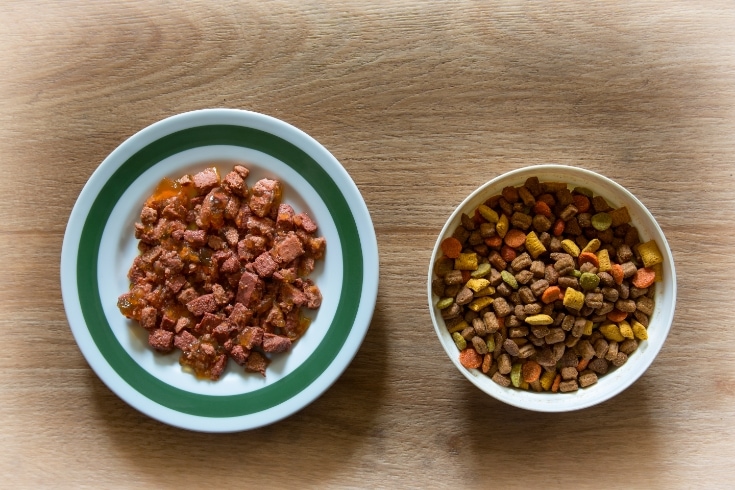
A diet that includes both wet and dry food helps to maintain hydration and keeps your cat’s teeth in good condition, so aim for a combo of both to provide a well-rounded nutritional approach. I feed my cats dry food in the morning and a portion of wet food in the evening, which they thoroughly enjoy!
Regulate Feeding Portions
Portion control is essential to prevent your cat from becoming obese or too thin, so follow the feeding guidelines on the cat food packaging, and adjust the portions based on your cat’s age, activity level, and body condition. If you are unsure how much to feed your cat, ask your vet for guidance.
Maintain Regular Feeding Times
Rather than allowing your cat to graze throughout the day, establish a regular feeding routine. Cats thrive on a regular schedule, and having set feeding times allows you to monitor how much your cat is eating, making it easier to prevent health problems such as obesity.
Keep Hydration Levels High
Hydration is critical for your cat’s kidney function and overall health, so ensure your furry friend has fresh water available to her at all times, especially during hot weather or if you feed your cat a dry diet.
Adjust Diet According To Age And Health Status
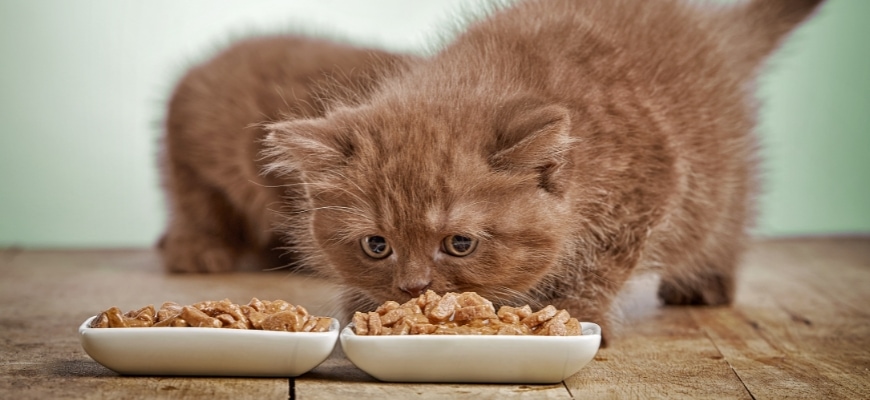
As we mentioned earlier, cats have different dietary requirements depending on their age and health status, so be sure to adjust your cat’s diet accordingly and ask your vet for advice if you’re unsure how much and what to feed your pet.
Limit Treat Intake
Although cats love treats, and we encourage you to use them during positive reinforcement training sessions, too much of a good thing can lead to obesity and its associated health problems. So, limit your cat’s treat intake and maybe substitute some of the treats for playtime or petting as a reward.
Provide Dietary Variety
You would soon get bored if you were served the same meal several times every day, and your cat is no different! So, try to offer your feline friend a wide variety of different flavors and textures of food to prevent boredom and potential sensitivities to specific ingredients from developing. In addition, providing your cat with dietary variety also helps to mimic the diversity of a cat’s natural diet.
Monitor Your Cat’s Weight Regularly
It’s important to monitor your cat’s weight regularly as fluctuations in weight can warn you of the onset of potential health problems, such as hyperthyroidism and diabetes.
Be Mindful Of Food Allergies And Intolerances
Some cats develop allergies or sensitivities to certain protein sources and other ingredients, commonly beef or chicken. If you notice any signs of allergies when grooming your cat, such as flaky skin, or if she starts having bouts of diarrhea, consult your vet.
Consult With Your Vet For Dietary Advice
If you are new to cat ownership, have a chat with your vet for guidance on appropriate portion sizes, dietary changes, or any concerns you have about your cat’s general health.
Consider Professional Nutrition Consultations For Homemade Diets
If you decide to take the DIY route and create your own homemade cat food, we advise you to consider asking a professional animal nutritionist for advice to ensure your cat’s diet contains everything she needs to remain healthy.
Prioritize Dental Health When Choosing Food
As we mentioned earlier, dry food or kibble removes the bacteria that cause plaque and tartar from your cat’s teeth as she crunches her meal. However, bear in mind that very young kittens and senior cats with teeth missing might struggle to eat dry food, so you might want to consider offering your cat dehydrated food instead.
Pay Attention To Behavioral Changes Around Feeding Time
Some cats become aggressive at feeding time, especially in a multi-cat household where competition and squabbling can break out. If that happens, you’ll need to train your cat to change her unacceptable behavior.
Understand And Interpret Pet Food Labels
Understanding and interpreting pet food labels is crucial for ensuring that you give your cat the correct nutrition.
Reading and Understanding Cat Food Labels
Cat food labels contain important information about the product ingredients, nutritional content, and feeding guidelines, and it’s important that you understand them.
Product Name: The product name should give you a big clue about the main ingredients. For example, a cat food labeled “Chicken and Rice Cat Food” should contain mostly chicken and rice.
Guaranteed Analysis: This section gives you the approximate minimum or maximum percentages of crude protein, crude fat, crude fiber, and moisture the food contains. Note that these figures are estimates and don’t represent precise nutritional values.
Ingredient List: The product ingredients are listed in descending order by weight. Look for foods with whole protein sources, such as chicken or fish, at the top of the list, and avoid those with terms like “meat byproducts” or “animal digest” that often indicate the food contains mostly padding with little nutritional value.
Feeding Directions: The manufacturer’s feeding directions suggest how much food you should feed your cat based on age and body weight.
Interpreting Nutritional Adequacy Statements
Nutritional adequacy statements tell you whether the food provides a complete and balanced diet according to established standards. Phrases to look out for include,
- “Formulated to meet the nutritional levels established by the AAFCO Cat Food Nutrient Profiles for [life stage(s)].” That means the food should provide all the nutrients that a cat in that specific life stage needs to thrive, for example, a kitten, adult, or senior cat.
- “Complete and Balanced.” A complete and balanced food contains all the essential nutrients necessary for your cat’s health, and you should choose food with that statement on the packaging for your pet’s main diet.
Deciphering Ingredients Lists
The ingredients list helps you understand what the food is composed of, enabling you to decide whether that diet is right for your cat.
Named Protein Sources: The named protein sources should always be the primary ingredients, e.g., chicken, turkey, and fish. Since cats are obligate carnivores, a portion of high-quality cat food should always contain mostly meat protein with little or no vegetables, which a cat’s digestive system can’t easily process.
Limited Fillers: Steer clear of foods containing fillers, such as corn, wheat, and soy, which offer little nutritional value.
Specific Ingredients: Look for foods containing specific ingredients, for example, chicken rather than poultry. That’s especially important when feeding cats with food allergies or sensitivities because you need to know exactly what’s in the food to avoid triggering an allergic reaction.
What Are Common Cat Feeding Mistakes?
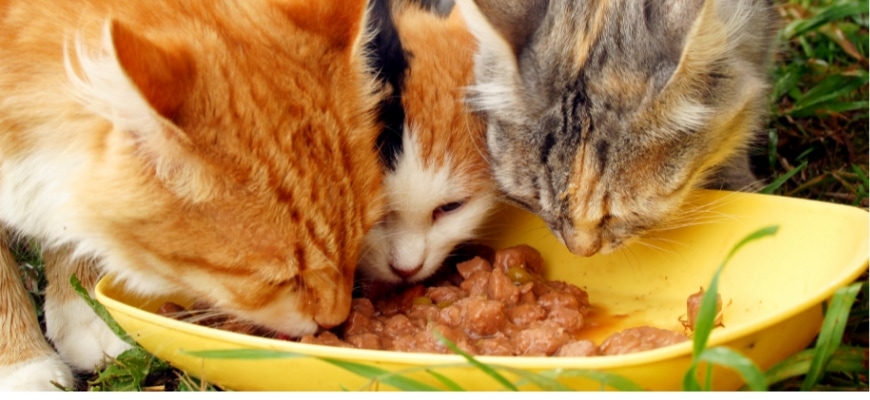
As you know, feeding your cat the proper nutrition is critical for her health and well-being. However, choosing the correct food and feeding it to your cat in the right amounts can be harder than you think, and it’s easy to get it wrong.
Here are a few common cat-feeding mistakes to be aware of so that you can avoid making them yourself.
Overfeeding Or Free-Feeding
It’s all too easy to overfeed your cat, especially if you allow her to graze or free-feed throughout the day. Rather than leaving the food out for your cat to help herself when she fancies a snack, set a feeding routine for your pet, and measure the food out correctly according to the manufacturer’s guidelines or veterinary advice.
Feeding A Dog’s Diet To Cats
Cats have unique dietary needs that differ from those of dogs. Never feed your cat dog food since it lacks the Essential nutrients that cats need, such as taurine.
Neglecting To Measure Meal Portions
Although it can be tempting to simply eyeball food portions, that can lead to inconsistent or overfeeding, causing potential weight gain problems for your cat. Instead, use a measuring cup and feed your cat the right amount of food for her size and activity levels.
Skipping Regular Feeding Schedules
Cats thrive on a regular daily routine, so don’t skip your cat’s regular feeding times, as that can cause digestive issues and stress.
Over-Reliance On Dry Food
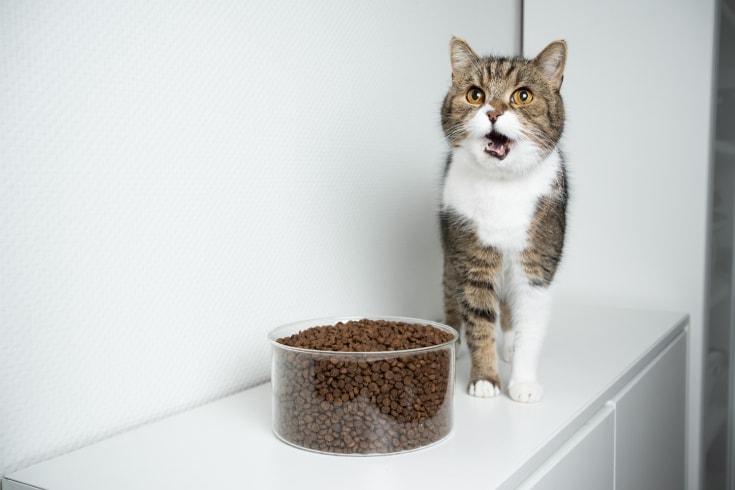
Although feeding dry cat food is a convenient option, dry food lacks the moisture content your cat needs in her diet. instead, feed your cat a combination of wet and dry food to help keep her hydrated and prevent kidney and urinary issues.
Neglecting Hydration
Interestingly, cats often don’t drink enough water, especially if they are on a dry food diet. To encourage your cats to drink more, ensure fresh water is always available, and perhaps consider including wet food in your cat’s diet to increase her daily moisture intake.
Ignoring Age-Specific Dietary Needs
Cats of different ages have different dietary needs, so always choose an age-specific diet for your pet, and be sure to adjust the diet throughout your cat’s life.
Feeding Too Many Treats
Although we recommend using treats as rewards during training, don’t overdo it, or your cat could become overweight, and her diet becomes unbalanced.
Neglecting Dietary Changes In Response To Health Issues
If your cat develops health issues, such as allergies or kidney problems, work with your vet and change your cat’s diet accordingly.
Disregarding The Importance Of Variety
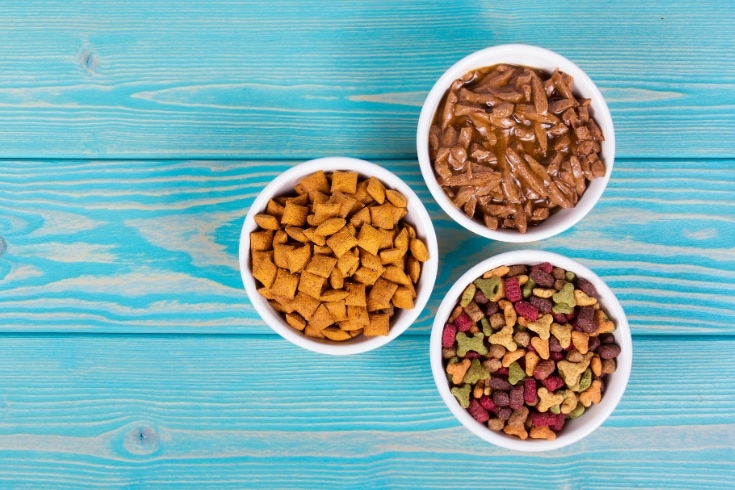
If you were fed the same meal every day, you would quickly become bored, and your diet would be unbalanced. The same applies to your cat, so change things regularly to prevent boredom and food sensitivities.
Ignoring Food Allergies Or Intolerances
If you notice that your cat has a skin allergy or digestive upset, it could be that she is intolerant to something in her diet. Don’t ignore that! discuss your cat’s diet with your vet, and consider changing to a hypoallergenic food instead.
Failure To Monitor Weight And Adjust Diet Accordingly
Weigh your cat regularly and assess her body condition so that you can adjust your pet’s diet if she begins losing or gaining weight.
Remember that weight gain or loss can be indicative of an underlying health issue, such as hyperthyroidism, so ask your vet for advice if your cat’s weight suddenly fluctuates.
Neglecting Dental Health In Food Choices
Include food that promotes dental health, such as crunchy kibble or special dental treats, to keep your cat’s teeth clean and prevent gingivitis and feline dental disease.
Insufficient Protein Intake
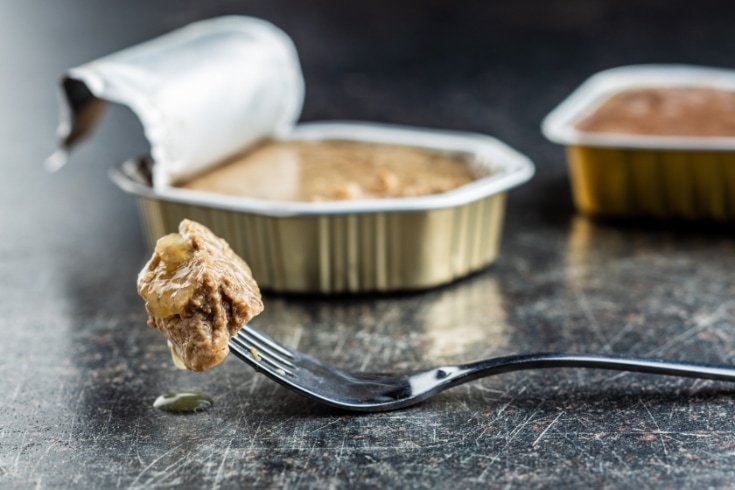
Cats are obligate carnivores that need a meat-based protein source in their diet, so be sure to choose cat food with whole meat as its primary ingredient.
Not Reading And Understanding Pet Food Labels
Take the time to read and learn to understand pet food labels so that you can choose a nutritious, balanced diet for your cat.
Self-Preparing Diets Without Proper Knowledge And Balance
If you decide to take the DIY route and prepare your cat’s meals at home, be sure to do plenty of research and buy the best ingredients to create a balanced diet that meets your cat’s nutritional needs.
Ignoring Behavioral Changes Related To Feeding
Pay attention to your cat’s behavior at feeding times, and if she shows a sudden change in appetite or eating habits, that could indicate an underlying health problem, such as a damaged tooth. If your cat’s behavior changes, always seek veterinary advice.
How Does Poor Nutrition Affect Cat Training And Behavior?
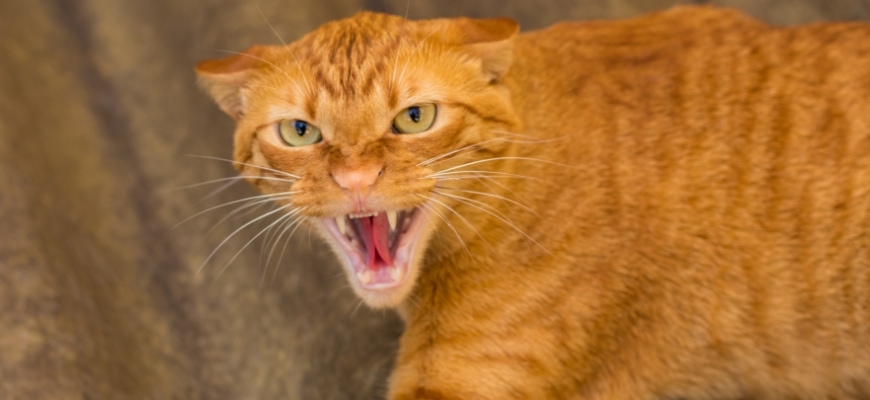
Proper nutrition is essential for your cat’s overall well-being, directly influencing her physical health, cognitive abilities, and energy levels, which in turn affects your feline friend’s behavior and responsiveness to training.
If your cat receives only poor nutrition, she could become overweight and even aggressive, adversely impacting her behavior and physical ability to learn tricks and new commands.
Here’s how a poor diet can affect your cat’s training and behavior.
Development Of Aggressive Or Irritable Behavior
A lack of essential nutrients in your cat’s diet can cause neurotransmitter imbalance, leading to heightened stress levels and aggressive, irritable behavior. Poor nutrition can therefore affect your cat’s mood and make her more difficult to train and handle.
Increased Risk Of Obesity
If you feed your cat a poor-quality diet, she will probably eat more to try to compensate for nutrient deficiencies in the food she receives. That overconsumption typically contributes to obesity, leading to reduced activity levels and lethargy, making training more challenging and less enjoyable for you and your cat.
Increased Lethargy And Decreased Activity Levels
Your cat’s energy levels are directly influenced by the nutrients she gets from her diet. Poor nutrition often leads to lethargy and decreased activity levels, reducing your pet’s enthusiasm for play, exercise, and training. If your cat is less active, she will be less responsive to training and slower to learn new commands and behaviors.
Reduced Ability To Learn And Retain Training Commands
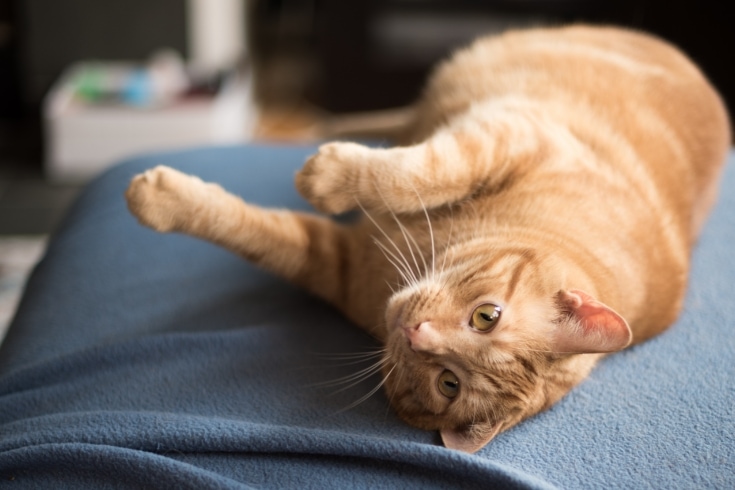
Nutrient deficiencies can affect your cat’s cognitive function, making it harder for your feline friend to learn and remember new training commands and tricks, leading to frustration for both you and your cat.
Increased Risk Of Developing Food Allergies And Intolerances
If you feed your cat a poor-quality diet lacking the nutrition she needs, her immune system could be compromised, making her more susceptible to developing food sensitivities or allergies.
Food allergies can cause tummy upsets, discomfort, and irritability, which will cause problems with your training program.
Reduced Immunity, Leading To More Health Issues
As mentioned above, a poor-quality diet impacts your cat’s immune system, potentially leaving her vulnerable to developing more health issues. A sick cat might be in discomfort, causing irritability, and will almost certainly be disinterested in training sessions.
Increased Risk Of Developing Compulsive Behaviors
Did you know that nutritional deficiencies can contribute to compulsive behaviors in cats, including over-grooming, wool sucking, and other repetitive actions? Those behaviors will undoubtedly interfere with your training sessions and could also affect your normal interactions with your pet.
Deterioration Of Physical Appearance And Coat Health
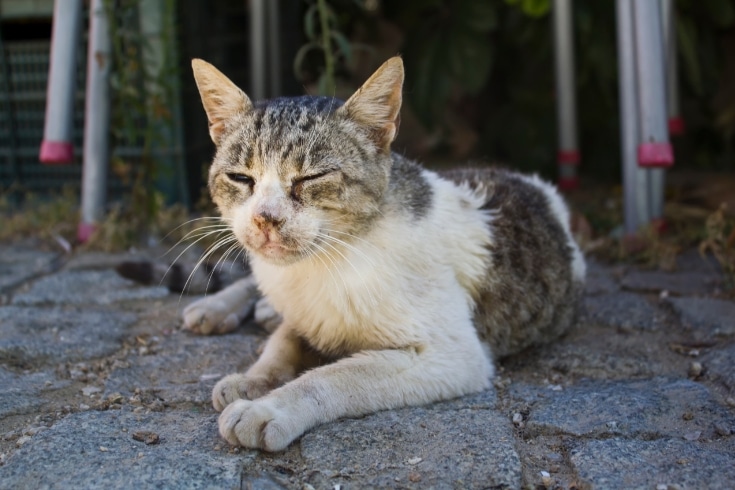
Poor nutrition often leads to a dull coat, flaky skin, brittle claws, and other signs of poor health, leaving your cat feeling under the weather and unwilling to take part in training sessions.
Decreased Lifespan And Quality Of Life
Chronic poor nutrition will undoubtedly have serious long-term effects on your cat’s health, potentially reducing her lifespan and diminishing her overall quality of life. If your cat struggles with health issues caused by inadequate nutrition, she won’t be as responsive to your training efforts and will probably have a lower overall vitality.
Increased Stress And Anxiety Levels
A poor quality, unbalanced diet will contribute to stress and anxiety in your cat, potentially causing behavioral problems and making training difficult.
Increased Risk Of Developing Dental Issues
Just as with people, a poor diet can increase the risk of dental problems in cats, including gingivitis, tooth decay, and dental pain. If your cat is in discomfort, she won’t want to take part in training sessions, potentially becoming irritable and even aggressive.
Increased Risk Of Organ Diseases Such As Kidney Or Liver Problems
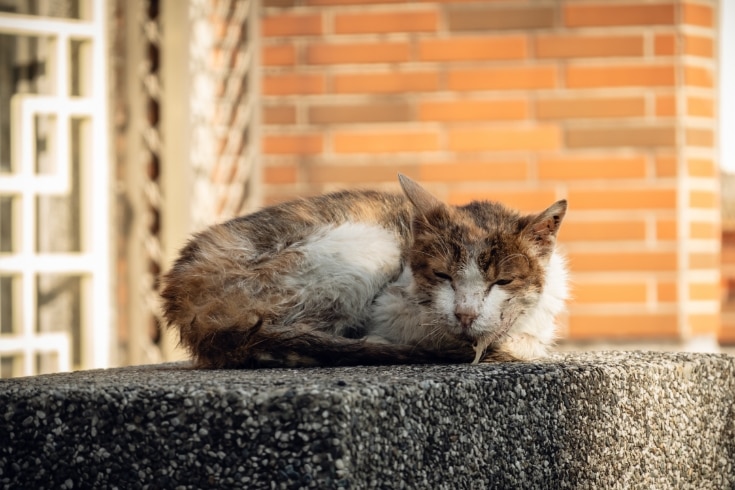
In addition to several common cat health problems, a chronic poor-quality diet can increase the risk of serious organ diseases, including kidney or liver conditions. These conditions can be incredibly debilitating for cats and will certainly contribute to behavioral issues and an overall lack of interest in training.
Changes In Appetite, Either Overeating Or Undereating
Poor nutrition can cause changes in your cat’s appetite, leading to overeating or undereating, which in turn can leave your cat lacking in energy and less receptive to training.
Increased Defecation And Urination Issues
If your cat’s diet is not properly balanced or doesn’t contain the nutrients she needs, gastrointestinal problems can develop, including diarrhea or constipation. those problems will make your cat uncomfortable and distract her from training.
Development Of Picky Eating Habits
A poor-quality diet can make a cat more picky in her eating habits, causing her to reject certain foods and lack focus during training sessions because she is still hungry.
Increased Risk Of Malnutrition And Associated Health Problems
The ultimate risk of poor nutrition in cats is malnutrition, leading to serious health problems ranging from weak bones to organ failure. Obviously, a malnourished, sickly cat will not be receptive to training, no matter how many rewards she is offered.
FAQs
In this part of our ultimate guide to cat nutrition and its relationship with cat training and behavior, we answer some of the most commonly asked questions on this fascinating, engrossing subject.
Is It Okay To Feed My Cat Only Dry Food?
Although dry food can form a valuable part of a cat’s basic diet, it’s important to include wet food as well because it helps keep your cat hydrated and offers the valuable variety that most cats love.
What Is The Importance Of Water In My Cat’s Diet?
Cats have a relatively low thirst drive when compared to dogs, but dehydration can lead to kidney problems and urinary issues. For that reason, fresh water is crucial for your cat’s overall health and should be available to her 24/7/365!
Can I Feed My Cat A Vegetarian Or Vegan Diet?
Absolutely not!
Cats cannot survive on a vegan or vegetarian diet because they are obligate carnivores, which means they need a high-protein diet that contains at least 70% whole meat.
How Do I Transition My Cat To A New Type Of Food?
When changing your cat onto a new type of food, it’s important to make the transition gradual to prevent causing digestive upsets.
Gradually combine the new food with the old, increasing the proportion of the new food over a week to ten days. During that time, keep a close eye on your cat and watch out for signs of diarrhea or constipation, which could mean that the new food doesn’t suit her.
Is It Okay For My Cat To Eat Dog Food?
No, you should not feed your cat dog food because it doesn’t contain the nutritional balance cats need.
Most cats won’t touch dog food anyway because they don’t find it particularly appetizing or appealing. In fact, I leave my puppy’s dish of kibble down all day for him to graze on, and neither of my cats shows any interest in it whatsoever.
Can I Feed My Cat “People” Food?
Although you can feed some human foods to your cat in small amounts, such as cooked meat, many human foods are toxic to cats, and a properly balanced cat diet is recommended.
What Are The Signs Of Food Allergies In Cats?
Common signs of food allergies in cats include flaky, itchy skin, rashes, vomiting, diarrhea, and ear infections. If you think your cat has a food allergy, ask your vet to take a peek at her and consider changing to hypoallergenic food.
Should I Feed My Cat A Grain-Free Diet?
According to recent research backed up by many vets, a grain-free diet could be dangerous to your cat’s health, potentially causing heart disease.
Plants don’t contain taurine, which is essential for cat health, making your feline friend more likely to develop a serious heart problem called dilated cardiomyopathy or DCM, resulting in an enlarged, weakened heart.
Can I Change My Cat’s Diet If They Have Health Issues Like Kidney Disease Or Diabetes?
I recommend you discuss your cat’s health issues and diet with your vet before you change her food. That said, many vets recommend specially formulated cat foods designed for animals with diabetes, kidney disease, and other serious health conditions, so be guided by their advice.
How Do I Manage A Picky Eater?
If your cat is a picky eater, try experimenting with different flavors and textures of high-quality cat food, and offer her a combination of wet and dry foods. Stick to a regular feeding routine and try not to give your cat too many treats during training sessions, as that could leave her feeling full at meal times, making her less likely to eat her food.
Conclusion
Cats are obligate carnivores that need at least 70% meaty protein in their diet to remain healthy, active, and responsive to training. Cats can be prone to dehydration because they have a low thirst drive, so be sure to provide your cat with fresh, clean water at all times, and consider including wet food in her diet to add extra moisture.
A poorly balanced diet can lead to serious health problems, including heart disease, kidney problems, malnutrition, and undesirable behaviors. So, always offer your cat a high-quality diet that discourages picky eating and keeps your pet active and responsive to her training sessions, and be careful you don’t overdo treat rewards that could cause obesity.
When choosing cat food for your pet, always read the product label, and pick a product with whole meat at the top of the ingredients list. If your cat has a health problem, such as diabetes or kidney disease, consider feeding her a specialized veterinary diet to help manage her condition.
A cat’s nutritional requirements change throughout her life stages, so be ready to change her food accordingly, and always consult your vet for guidance if you’re unsure what to feed your cat.
If your training sessions aren’t going as well as you hoped or your furry friend sometimes has an attitude problem, take a look at your cat’s diet. It could simply be that your pet isn’t getting the nutritional balance she needs.